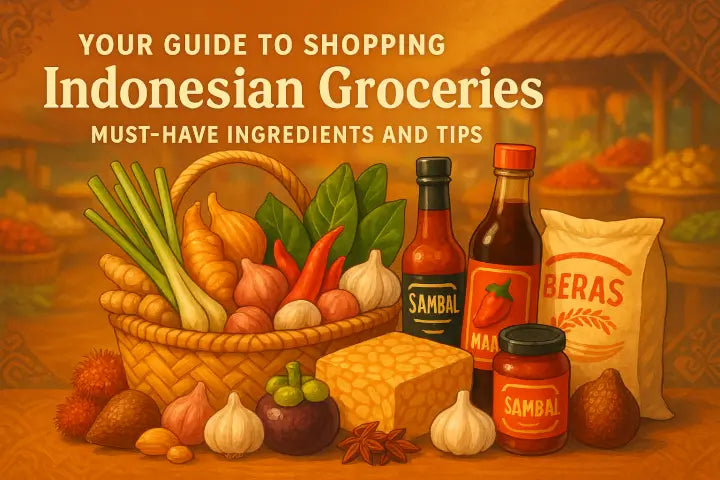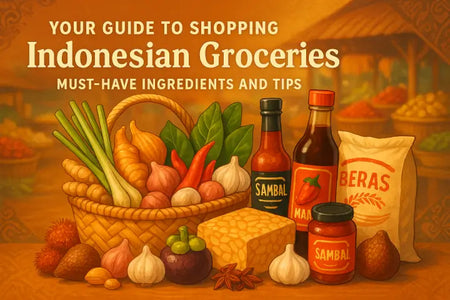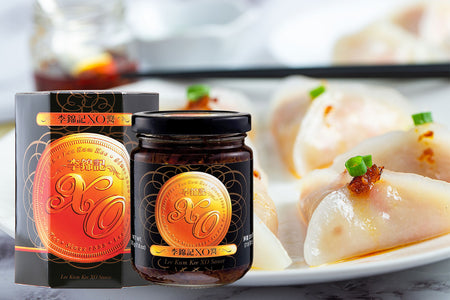Your Guide to Shopping Indonesian Groceries: Must-Have Ingredients and Tips

Welcome to a mouthwatering journey into the world of Indonesian cuisine! In this comprehensive guide, every shelf, spice jar, and tropical fruit at your local Indonesian market comes alive. Whether you’re seeking an Indonesian grocery near me to explore fresh produce or prefer the convenience of an Indonesian grocery online shop, this article is designed to be your go-to resource.
Get ready to dive into vibrant spices, pantry staples, and fresh ingredients that form the backbone of some of the world’s most exciting dishes. From aromatic rendang to sizzling satay skewers, each section unpacks the essentials and offers insider tips to shop like a pro—no PhD in food science required!
Discovering the Indonesian Market
Stepping into an Indonesian market is like entering a kaleidoscope of scents, colors, and flavors. The air is often perfumed with turmeric, lemongrass, and coconut milk, inviting curious food lovers to pause and sample. Whether you’re navigating narrow aisles jam-packed with exotic fruits or scanning shelves heavy with spice packets, the experience is a feast for the senses.
From bustling street-style stalls to well-organized aisles in a neighborhood Indonesian grocery store, each setting has its own charm. Local grocers greet you with warm smiles, ready to recommend the freshest turmeric root or the perfect sambal paste for that spicy kick. It’s a friendly, treasure-hunter vibe that keeps shoppers coming back for more.
Key Ingredients Found in an Indonesian Grocery Store
Spices and Herbs
Spices and herbs are the heart and soul of Indonesian cooking. Most grocers stock everything from dried galangal and candlenuts to kaffir lime leaves and star anise. These aromatics build the complex layers of flavor that make dishes truly unforgettable.
- Turmeric – Bright color and earthiness
- Galangal – Zesty, peppery notes
- Shallots – Sweetness and depth
- Galangal – Zesty, peppery notes
- Kaffir lime leaves – Citrus fragrance
Staples and Pantry Essentials
Venture deeper into an Indonesian grocery store and you’ll uncover a treasure trove of pantry essentials. Coconut milk, rice noodles, palm sugar, and sambal chili paste typically line the shelves. These staples are designed to make cooking authentic dishes not just possible, but delightfully simple.
Every pantry needs a handful of sauces too: kecap manis (sweet soy sauce), ikan teri (dried anchovies), and shrimp paste for that unmistakable umami hit. Stocking up on these basics ensures you’re always just a few steps away from whipping up your next Indonesian feast.
Fresh Produce and Proteins
Freshness matters! Most Indonesian markets carry an array of seasonal fruits and vegetables like jackfruit, snake beans, turmeric root, and pandan leaves. These ingredients are often used in both savory dishes and desserts, highlighting the cuisine’s versatility.
Protein options can range from chicken and beef to mackerel and dried anchovies. For vegetarians and vegans, tempeh and tofu are go-to ingredients. They soak up spices beautifully, making them star performers in vegan rendang or gado-gado salad.
Shopping Options: Indonesian Grocery Near Me vs Online
Brick-and-Mortar Indonesian Grocery Near Me
Visiting an offline Indonesian grocery near me offers immediate, tactile benefits. You can feel the firmness of fresh turmeric, sniff test the kaffir lime leaves, and chat with shopkeepers about the freshest catch of the day. This in-person experience makes ingredient selection intuitive.
Maps and local listings often highlight hidden gems in ethnic neighborhoods. If you’re after an adventure, a quick search for “Indonesian grocery near me” can uncover family-run markets where recipes have been perfected across generations.
Indonesian Grocery Online
For those with busy schedules or living in areas without many local options, an Indonesian grocery online is a godsend. Many e-commerce platforms curate authentic ingredients and ship them right to your door. From sambal varieties in resealable pouches to vacuum-packed tempeh, shopping online is as easy as a few clicks and a secure checkout.
Be sure to read product descriptions carefully; look for shelf-stable items like dried spices and sauces, plus refrigerated goods like tofu with insulated packaging. Convenient filters let you narrow down by category, brand, or price, so whipping up your favorite dish is just a delivery away.
Tips for Shopping at an Indonesian Market
Navigating an Indonesian market—whether in person or online—can feel like decoding a new language. Here are a handful of seasoned tips to make every trip a breeze:
- Start with a list of core staples (rice, coconut milk, spices). This stops the overwhelm and ensures you grab the essentials first.
- Chat with the vendor. They often have insider advice on seasonal produce and best buys.
- Compare prices across stalls or sites. Bulk purchases of rice or chilies can save you money in the long run.
- Check expiration dates on sauces and pastes. Freshness is key to authentic tastes.
- Ask for substitutions. If a hard-to-find ingredient is sold out, vendors may recommend an excellent alternative.
Armed with these pointers, shopping at an Indonesian grocery store becomes less of a mystery and more of an exhilarating hunt for culinary treasures. Embrace the sensory overload and remember: trying something new is half the fun!
Popular Indonesian Dishes and Grocery Ingredients
Nasi Goreng (Fried Rice)
Nasi goreng is Indonesia’s beloved comfort food—a fragrant fried rice dish that can be whipped up in minutes. The base usually features leftover rice, kecap manis, shallots, garlic, and chilies. Many grocery aisles carry ready-made paste blends to streamline the process further.
Common toppings include fried eggs, prawns, satay skewers, or crispy shallots. Grab these from your local Indonesian grocery near me, or add them to your online cart—this dish shines with simple, quality ingredients.
Rendang (Spicy Beef Stew)
Originating from West Sumatra, rendang is a rich, slow-cooked beef stew simmered in coconut milk and spice paste. Key ingredients you’ll find at any Indonesian market include dried chilies, galangal, lemongrass, and turmeric.
Achieving that melt-in-your-mouth texture takes time and patience, but cooking rendang is a culinary adventure well worth the effort. The aroma alone—wafting through the kitchen—promises an unforgettable meal.
Sate (Skewers)
Sate, or satay, consists of marinated meat pieces threaded onto bamboo sticks, then grilled to smoky perfection. Classic versions use chicken or lamb, but you’ll also find tofu, tempeh, and even seafood varieties.
Don’t forget the peanut sauce—a creamy blend of ground peanuts, sweet soy sauce, and spices. Many Indonesian grocery online shops carry pre-ground peanut sauces or paste, so you can focus on the grilling and garnishes.
Essential Kitchen Tools for Indonesian Cooking
Preparing authentic Indonesian dishes often calls for specialized tools. While you don’t need an entire arsenal, a few key items can make a world of difference:
- Mortar and Pestle (Cobek & Ulekan): Ideal for grinding spices and making sambal from scratch.
- Rice Cooker: Ensures perfectly steamed rice every time, freeing you up to focus on sauces and side dishes.
- Wok or Large Skillet: Provides even heat distribution for stir-frying or deep-frying.
- Steamer Basket: Perfect for making dumplings and fresh rice cakes.
Having these tools on hand translates to authentic flavors and textures that elevate home-cooked meals to restaurant quality. Plus, they’re great conversation starters when friends ask, “What’s that cool gadget?”
Storing Indonesian Ingredients: Shelf Life and Tips
Proper storage keeps ingredients fresh and flavors intact. In tropical climates, humidity and heat can impact shelf life, so here’s a handy table summarizing common pantry items and how best to store them:
| Ingredient | Storage Method | Typical Shelf Life |
|---|---|---|
| Dry Spices (turmeric, cumin) | Cool, dark cabinet in airtight jars | 6–12 months |
| Coconut Milk (canned) | Pantry before opening; fridge after opening | 2–3 years (sealed); 4–5 days (opened) |
| Sambal Paste | Refrigerate in sealed container | 1–2 months |
| Fresh Herbs (kaffir leaves, lemongrass) | Refrigerate in plastic bag or wrap | 1–2 weeks |
| Tempeh & Tofu | Refrigerate; freeze if unused after opening | 1 week (fridge); 1–2 months (frozen) |
By following these simple guidelines, grocery finds from an Indonesian market stay at peak freshness, helping every dish taste its best. When in doubt, label containers with purchase dates—no more guesswork!
Indonesian Grocery Store Etiquette and Culture
Shopping at an Indonesian grocery store is as much a cultural experience as it is a culinary one. Vendors often appreciate polite greetings and questions about their products. A simple “Selamat pagi” (good morning) can go a long way in building rapport.
When sampling fresh produce or asking for a taste of sambal, it’s customary to thank the vendor afterward. This friendly exchange enriches the shopping trip and may even unlock special discounts or recipe tips.
Conclusion
Exploring an Indonesian grocery store—whether you search for “Indonesian grocery near me” or browse an Indonesian grocery online catalog—opens the door to a world of culinary delights. Armed with the right ingredients, tools, and insider tips, you’ll feel confident recreating signature dishes from across the archipelago.
So next time wanderlust hits your taste buds, venture into the aisles of your local Indonesian market. Scoop up fresh turmeric, palm sugar, and a rainbow of chilies. Your kitchen awaits an island-inspired feast that’s bound to brighten any weeknight!
FAQs
What is an Indonesian grocery store?
An Indonesian grocery store specializes in ingredients and pantry staples native to Indonesia’s diverse cuisines. You’ll find spices like turmeric and galangal, sauces such as kecap manis, fresh produce like pandan leaves, and proteins including tempeh and dried anchovies—all in one vibrant shop.
How do I find an Indonesian grocery near me?
To locate an Indonesian grocery near me, try searching online directories or map services using that exact phrase. Ethnic neighborhoods, international food markets, and specialty stores often carry Indonesian products. Calling ahead can confirm availability of specific items you need.
Can I buy Indonesian ingredients from an online store?
Absolutely! An Indonesian grocery online offers convenient access to authentic ingredients shipped directly to your door. Look for retailers with refrigerated packaging for perishables and clear listings for sauces, spices, and snacks—making it simple to shop from anywhere.
What are some must-have pantry staples from an Indonesian market?
Essential items include coconut milk, rice, sambal paste, kecap manis (sweet soy sauce), turmeric powder, and tempeh or tofu. These staples form the base of beloved dishes like nasi goreng, rendang, and gado-gado.
How should I store ingredients from an Indonesian market?
Store dry spices in airtight jars away from heat and light. Keep coconut milk cans in a cool pantry, refrigerating after opening. Fresh herbs and aromatics like lemongrass belong in the fridge, while tempeh and tofu should be used within a week or frozen for longer storage.






